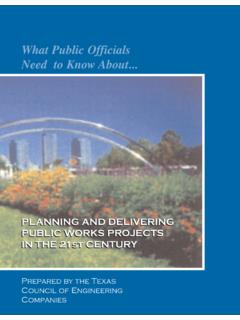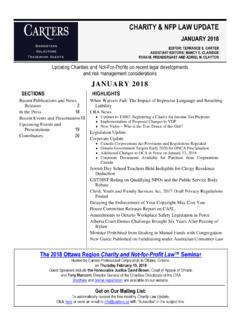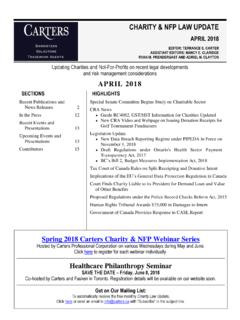Transcription of MUNICIPAL ANNEXATION IN TEXAS
1 MUNICIPAL . ANNEXATION . IN TEXAS . IS IT REALLY THAT COMPLICATED? . SCOTT HOUSTON. General Counsel TEXAS MUNICIPAL League 1821 Rutherford Lane, Suite 400. Austin, TEXAS 78754. 512-231-7400. -Updated May 2016- TABLE OF CONTENTS. I. Introduction ..5. II. A (Not So) Brief Legislative Background of III. The Importance of MUNICIPAL ANNEXATION Authority to the Life and Prosperity of TEXAS ..17. IV. An Overview of How ANNEXATION Works ..18. A. The Three Questions of ANNEXATION ..18. B. ANNEXATION Plan ..21. C. Procedures ..24. V. ANNEXATION Authority ..26. A. Requirement to Offer Development Agreement ..26. B. Requirement that Area be in the City's ETJ ..30. C. Authority to Unilaterally Annex an Area ..32. 1. Charter Provisions (Home Rule Cities) ..32. 2. Local Government Code Provisions (General Law Cities) ..32. D. Other ANNEXATION Authority ..34. 1. ANNEXATION by Petition of Area Voters ..34. 2. ANNEXATION by Petition of Area Landowners.
2 35. 3. Miscellaneous VI. Procedures for Areas Exempt From the ANNEXATION Plan Requirement ..37. A. Introduction ..37. B. ANNEXATION of Area Exempt from the ANNEXATION Plan Requirement ..37. 2. 1. 100 Tracts Exemption and Other Exemptions ..37. 2. Applicable Provisions ..38. 3. Procedure ..40. VII. Unilateral ANNEXATION after December 31, 2002 for Area Included in ANNEXATION Plan ..43. A. Inventory ..43. B. Applicable Provisions ..43. C. Service D. Procedure ..45. E. VIII. Other Matters Affecting All Annexations ..48. A. B. Secretary of State Notification ..49. C. Comptroller and Appraisal District Notification ..50. D. Filing with County Clerk ..50. E. Map of MUNICIPAL Boundaries and Extraterritorial E-1. Right-of-Way Fees ..51. F. Disannexation ..51. 1. Disannexation for Failure to Provide Services ..51. 2. Home Rule Disannexation According to Charter ..53. 3. General Law Disannexation ..53. 4. Refund of Taxes and Fees.
3 54. IX. Miscellaneous ANNEXATION 3. A. Extraterritorial Jurisdiction Expansion and Release ..54. B. Validation and Presumed Consent ..56. C. Types of ANNEXATION Challenges ..57. D. City Motives for ANNEXATION Irrelevant ..58. E. Area Receiving Longstanding Treatment as Part of City ..58. F. Agreements in Lieu of ANNEXATION ..60. G. Prior Uses ..60. H. Special Districts/Water Supply Corporations ..62. I. Emergency Services Districts ..62. X. Provision of Services ..63. XI. Conclusion ..66. XII. Example Documents ..67. 4. I. INTRODUCTION. ANNEXATION , specifically unilateral ANNEXATION , is one of the most debated issues of MUNICIPAL authority. Rarely a week goes by that ANNEXATION battles do not show up in newspaper headlines across the state. Interesting, however, is the fact that from the enactment of the MUNICIPAL ANNEXATION Act in 1963 1 until fairly recently, the legislature rarely acted to broadly proscribe city authority in this area.
4 The legislative outlook for ANNEXATION changed dramatically in the 1990s. In 1996, the City of Houston annexed an upscale subdivision called Kingwood, bringing in almost 50,000 new residents. At the time, Kingwood was a twenty-year-old subdivision that was fully built-out with large, expensive homes. When the developer first approached Houston for water and sewer extensions, the city and the developer agreed that when the City of Houston got closer to the subdivision, the subdivision would consent to ANNEXATION . It took Houston close to twenty years to get there. Upon the city's arrival, the citizens of Kingwood organized and showed up literally in busloads at the Seventy- Fifth Legislative Session in 1997 with banners that read Free Kingwood.. The protests of Kingwood residents and others ultimately resulted in the passage of senate bill 89 in 1999, the provisions of which are still being debated (and often litigated) over 15 years later.
5 89 did not prohibit cities from annexing. The bill merely made the process much more complex, expensive, and time consuming in certain circumstances. However, the changes made by 89 do not have much significance for general law cities and home rule cities that annex smaller, sparsely- occupied areas or annex only by petition. The greatest impact is on home rule cities that wish to exercise unilateral ANNEXATION authority to bring in large, existing residential subdivisions. In response to several annexations over the past years, several state legislators have stated that they believe that residents of an area should have the right to vote on whether or not to be annexed. The ANNEXATION policies of one TEXAS city succinctly and clearly summarize the arguments against voter permission: Cities annex territory to provide urbanizing areas with MUNICIPAL services and to exercise regulatory authority necessary to protect public health, safety and welfare.
6 ANNEXATION is also a means of ensuring that residents and businesses outside a city's corporate limits who benefit from access to the city's facilities and services share the tax burden associated with constructing and maintaining those facilities and services. ANNEXATION may also be used as a technique to manage growth. 1. Act of April 29, 1963, MUNICIPAL ANNEXATION Act, 58th Leg., , ch. 160, 1963 Tex. Gen. Laws 447. 5. Any materials provided by TML are intended for informational purposes only and should not be substituted for the advice of local counsel. For a PDF copy of this paper, please visit Please contact Scott Houston with the TML Legal Services Department at 512-231-7400 or with questions or concerns. II. A (NOT SO) BRIEF LEGISLATIVE BACKGROUND OF ANNEXATION . The original method of incorporation of cities under the Republic of TEXAS , and later the State of TEXAS , was by special law. In other words, the Congress of TEXAS or the State Legislature passed a bill , very similar in appearance to a modern home rule charter, that incorporated a city and delineated its powers and duties.
7 For the most part, special law cities had no ANNEXATION authority. To expand the city's boundaries, the congress or legislature had to amend the law that created the city. In 1858, the first statute allowing incorporation of a city under the general laws was passed. An 1858 amendment allowed for ANNEXATION by petition, and this law, along with others passed over the next several years, became the basis for general law ANNEXATION by petition as it is known today. In 1912, the voters of TEXAS passed the Home Rule Amendment to the TEXAS Constitution. TEX. CONST. Art. XI, 5. This amendment and its accompanying legislation in 1913 gives cities over 5,000 population that adopt a home rule charter by election the full power of local self government, including the ability to unilaterally annex property. Except for the Home Rule Amendment, relatively few substantial changes were made to ANNEXATION laws from 1858 through 1963. In 1963, the Legislature enacted the MUNICIPAL ANNEXATION Act (Act).
8 The Act provided procedures for ANNEXATION and created the concept of extraterritorial jurisdiction (ETJ). The Act is now codified in Chapters 42 and 43 of the TEXAS Local Government Code. As mentioned previously, from the enactment of the Act until the passage of 89 in 1999, the Legislature rarely acted on a broad scale to restrict or modify city ANNEXATION authority. 2. Nonetheless, ANNEXATION powers have given rise to complaints and have routinely come under attack in the legislature. The residents of unincorporated areas rarely favor being brought into a city involuntarily, and any city that has gone through a major ANNEXATION is well aware of how controversial the process can become. Rural landowners and others have regularly turned to their legislators for relief from city expansions, with the result that bills to curb unilateral annexations have surfaced in every session for the past fifty years. The battle heated up substantially in 1987, and the legislature passed a bill ( 962, now codified in Local Government Code Sections and ).
9 That, among other things, prohibited strip annexations of less than 1,000 feet (as 2. Most of the previous information in this introduction is summarized from D. Brooks, MUNICIPAL Law and Practice, 22 TEXAS Practice Ch. 1 and T. O'Quinn, History, Status, and Function, Introduction to Title 28. of the TEX. REV. CIV. STAT. (Vernon 1963). 6. opposed to the previous standard of 500 feet) and changed the requirement that the construction of capital improvements necessary for providing services to newly annexed areas be initiated within 2 years to a new requirement that construction begin within 2. years and be substantially complete within 4 years. In 1989, the onslaught continued. That year's major piece of legislation ( 3187, now codified in Local Government Code Section ) provided, in addition to other requirements, that cities provide full MUNICIPAL services to annexed areas within 4 . years, but the provision that capital improvements must only be substantially completed within that 4 years remained intact.
10 Full MUNICIPAL services are defined as services provided by the annexing municipality within its full purpose boundaries, . but cities retained the right to provide varying levels of service for reasons related to topography, land use, and population density (and they still do). Very few bills related to ANNEXATION were considered by the 1991 legislature. The 1993. legislature didn't seriously consider any bills that would have restricted the ANNEXATION powers of home rule cities, but the House Urban Affairs Committee was charged with the task of examining the subject of ANNEXATION during the 1994 interim leading up to the 1995 legislative session. The committee held several public hearings around the state. Many cities and TML staff testified at those hearings. Landowners who had been annexed or who feared ANNEXATION also testified before the committee. During the 1995 session, only one ANNEXATION bill passed, but the 1997 legislative session turned out to be the Mother of All ANNEXATION Battles.













